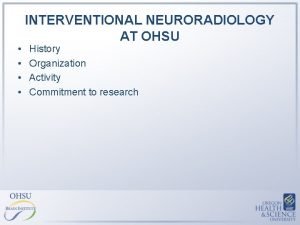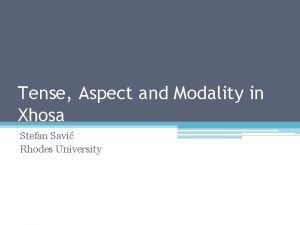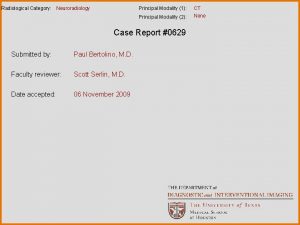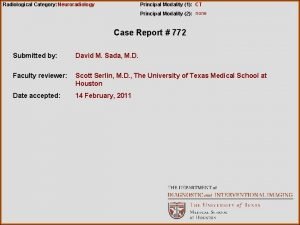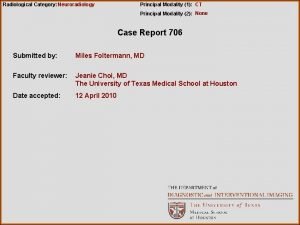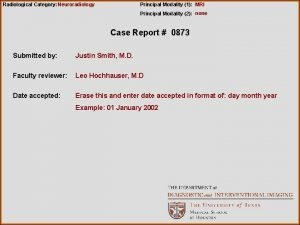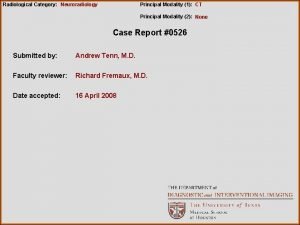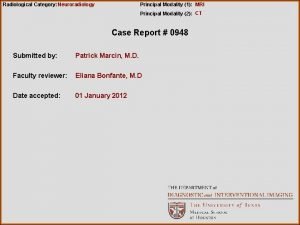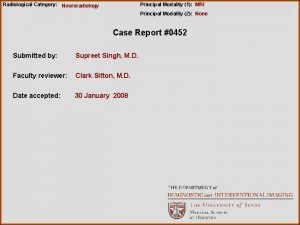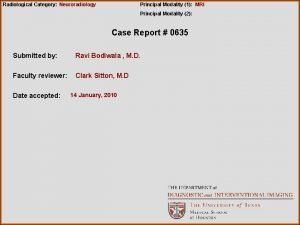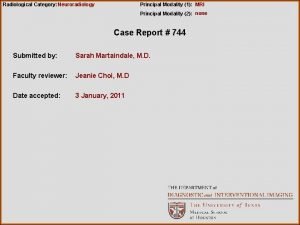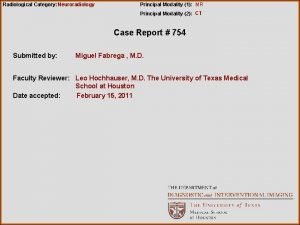Radiological Category Neuroradiology Principal Modality 1 CT Principal












- Slides: 12

Radiological Category: Neuroradiology Principal Modality (1): CT Principal Modality (2): None Case Report #0380 Submitted by: Jeanie Choi, M. D. Faculty reviewer: Leo Hochhauser, M. D. Date accepted: 04 March 2007

Case History 30 year old female with seizures and mental retardation.

Radiological Presentations

Radiological Presentations

Radiological Presentations

Radiological Presentations

Test Your Diagnosis Which one of the following is your choice for the appropriate diagnosis? After your selection, go to next page. • Porencephalic cyst • Open lip schizencephaly • Encephalomalacia • Arachnoid cyst

Findings and Differentials Findings: A unilateral right frontal CSF filled cleft is identified. The cleft is in communication with the right frontal horn. The lining of the cleft demonstrates increased density consistent with gray matter. There is absence of the septum pellucidum. Differentials: • Schizencephaly • Porencephaly • Encephalomalacia • Arachnoid cyst

Discussion Schizencephaly develops from abnormal neural proliferation secondary to an in utero insult thought to occur between 2 -5 months gestation. Focal destruction of germinal matrix is thought to be the inciting event. There is resultant formation of a cleft extending from the pial surface of the cortex to the ventricle ependyma. The clefts are lined partially or completely by gray matter and may be unilateral or bilateral. Clefts may be either closed lip (type I), with apposition of grey matter, or open lip (type II), with CSF filling the cleft. Type II defects are associated with more severe impairment in the form of seizures, mental retardation, spasticity, and hemiparesis. Type I defects may present with milder symptomatology, and therefore may not be diagnosed until adulthood. Closed lip schizencephaly is associated in 35 -50% with septo-optic dysplasia, in which there are small optic nerves and chiasm, dysgenesis of the corpus callosum, absence or partial absence of the septum pellucidum and abnormalities of the hypothalamic-pituitary axis. Open lip defects are associated in up to 90% with absence of the septum pellucidum.

Discussion Encephalomalacia from an early infarct or other perinatal injury may also demonstrate a cortical defect. Volume loss will be noted with internal septations usually noted in the defect, lined by astrocytes. Porencephaly refers to the formation of a CSF cavity in the brain parenchyma. The cavity may communicate with the ventricle. The inciting event is a vascular insult or infection during the late in utero or early perinatal period. It is always an acquired event but may be present at birth (connatal). Sequelae from trauma, vascular insult or infection may also lead to acquired porencephalic cysts. These CSF-filled spaces are lined by white matter, which serves as the major differentiator from schizencephaly. Arachnoid cysts are extraaxial CSF spaces that may occasionally exert mass effect upon the adjacent cortex. The frequently associated thinning of the adjacent calvarium is considered to result from remodeling of the inner table by the transmitted CSF pulsations. The majority of arachnoid cysts occur in the middle cranial fossa which is thought to result from failure of the embryonic meninges to fuse as the sylvian fissures form. The redundant arachnoid then slowly distends with CSF.

Diagnosis Open lip schizencephaly.

References Oh KY, Kennedy AM, Frias AE, and Byrne JLB. Fetal Schizencephaly: Pre- and Postnatal Imaging with a Review of the Clinical Manifestations. Radiographics 2005; 25: 647 -657. Diagnostic Imaging: Brain, Second Edition. Osborn et al. August 2004. Radiologic Pathology: Notes from the AFIP; 2006 -2007.
 Ohsu neuroradiology
Ohsu neuroradiology E-rate category 1 vs category 2
E-rate category 1 vs category 2 Center for devices and radiological health
Center for devices and radiological health National radiological emergency preparedness conference
National radiological emergency preparedness conference Radiological dispersal device
Radiological dispersal device Tennessee division of radiological health
Tennessee division of radiological health Birads scoring
Birads scoring Pacs modality workstation
Pacs modality workstation Modality
Modality Modality in software engineering
Modality in software engineering Sensory modality examples
Sensory modality examples Deontic modality
Deontic modality Modality in software engineering
Modality in software engineering
